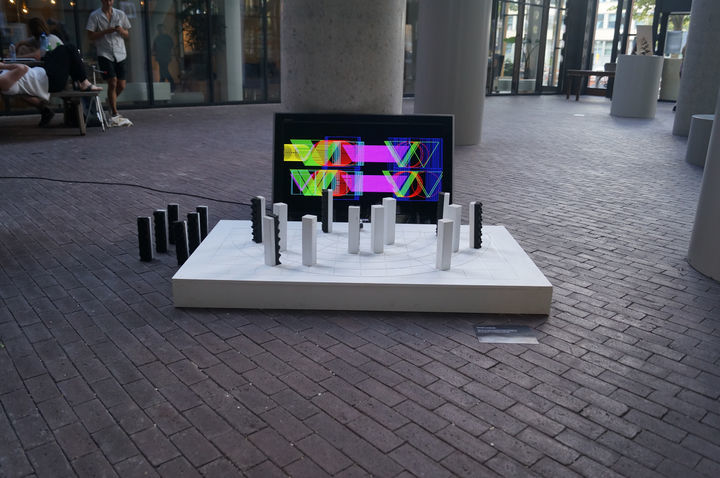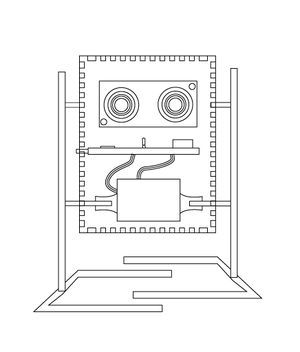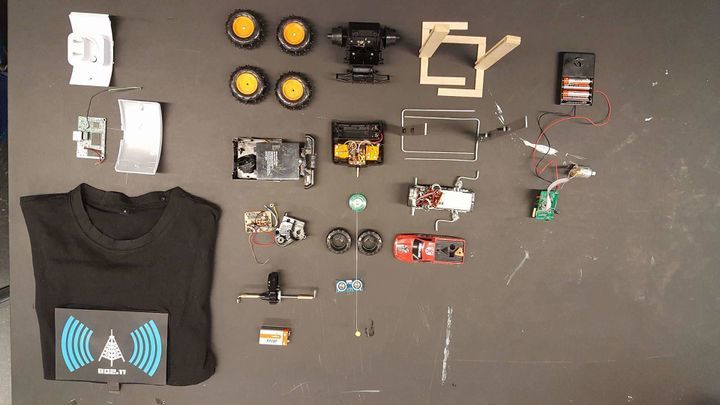Difference between revisions of "Research Wiki Page"
| Line 109: | Line 109: | ||
| − | [[File:Robot. | + | [[File:Robot.jpg|300px|thumb|left|upright=2.4|alt=A large clock tower and other buildings line a great river.]] |
[[File:Received 1423900350971452.jpeg|thumb|left|upright=2.4|alt=A large clock tower and other buildings line a great river.]] | [[File:Received 1423900350971452.jpeg|thumb|left|upright=2.4|alt=A large clock tower and other buildings line a great river.]] | ||
'''Electromagnetic Radiation''' <br> | '''Electromagnetic Radiation''' <br> | ||
| Line 117: | Line 117: | ||
<br> | <br> | ||
<br> | <br> | ||
| + | |||
'''Light Radiation''' | '''Light Radiation''' | ||
The next project was done together with Pascale. We have a mutual interest in material and handcraft, what made our project really fun to do. Our different knowledge in craft complementary each other especially during the experiments. That became clear with our first experiment. As a graphic designer and a bit fond of screen-printing, I know what ink supply we have at school. Pascale on the other hand has next to her big love for the ceramics, some experience in the photo art. We wondered what would happen if we dip a blank piece of paper in UV - light sensitive ink and put it in a camera obscure. Would it result in a picture? It didn’t, but our curiosity grew and we went on experimenting further by mixing UV- sensitive ink and the materials in the ceramics. It worked! Almost all of the materials changed color holding it in UV-light. First thing noticed was the beauty in it slow changing color and the fact that it would only last for 5 minutes the second you take it out of the light. This is when we realized that we had more in common as artists. We both feel that the world around us is moving in such a fast past, that we humans can’t simply catch up anymore. We live in a world where we are surrounded by digital screens, where everything is instant and can be saved forever. So we went for the latex material and decided to make a big screen out of it. Together with a glove tooled with UV-lights we challenge the perspective and let you experience ephemeral drawing. | The next project was done together with Pascale. We have a mutual interest in material and handcraft, what made our project really fun to do. Our different knowledge in craft complementary each other especially during the experiments. That became clear with our first experiment. As a graphic designer and a bit fond of screen-printing, I know what ink supply we have at school. Pascale on the other hand has next to her big love for the ceramics, some experience in the photo art. We wondered what would happen if we dip a blank piece of paper in UV - light sensitive ink and put it in a camera obscure. Would it result in a picture? It didn’t, but our curiosity grew and we went on experimenting further by mixing UV- sensitive ink and the materials in the ceramics. It worked! Almost all of the materials changed color holding it in UV-light. First thing noticed was the beauty in it slow changing color and the fact that it would only last for 5 minutes the second you take it out of the light. This is when we realized that we had more in common as artists. We both feel that the world around us is moving in such a fast past, that we humans can’t simply catch up anymore. We live in a world where we are surrounded by digital screens, where everything is instant and can be saved forever. So we went for the latex material and decided to make a big screen out of it. Together with a glove tooled with UV-lights we challenge the perspective and let you experience ephemeral drawing. | ||
Revision as of 14:10, 24 January 2017
'Who are you?' Said the Caterpillar, were Alice replied:
'I – I hardly know, sir, just at present–at least I know who
I WAS when I got up this morning, but I think I must have
been changed several times since then.'
This confusion Alice (in Wonderland) experience, after a long trip down the tunnel ending in an obscure
unknown land and turning into so many different sizes a day, is exactly how I experienced these last
few years at school. I find knowing who I am and what it is that I do difficult, because my interests
changes like day and night.
In my first year I called myself a Graphic Designer, just as my study labelled. During my second year
I developed my drawing skills more and more, what made me call myself a Graphic Designer/Illustrator.
I establish a signature style and that seemed to be recognized as well. I managed to get paid assignments
and I felt like I had found my way of working. It really felt that: ‘who I am’ seemed much clearer back then.
The ‘slash’ that’s trying real hard to put these two occupations together didn’t really bother me yet.
This year, my last, I’ve chosen the minor Digital Craft. It was mainly the crafting that draw my attention.
The idea of working with my hands, the ‘do first think later’ state of mind, is what made me enthusiastic.
I was a bit insecure about the digital part, because I never felt much for it. My work, made digital or not,
has always a handmade feel and/or with respect for tradition. But considering the digital era we live in,
I felt that I should master the thing a can then let go. During the course I began to appreciate the ‘digital’ part more.
I discovered that technology can be a great tool to my interest. My somewhat crazy ideas that before looked
impossible to others suddenly became possible. I reached to a point that I even build my own ‘machines’ now.
So each year I learn more and more interests occurred, but this also entailed more confusion.
I mean, how many more slashes can I add?
Being labeled a Graphic Designer feels a little like being called a draftsman, color artist, desktop layout artist
or something else that does not even come close to describing what I do. I believe this is likely true of most
of my fellow class mates coming from the same department. The profession Graphic Design is becoming
a broader understanding and Digital Craft, being an autonomous minor, only made that clearer for me.
Looking around me I see a world with each day more independent artists, shop owners and freelancers.
I call them Centipedes. Much different than a few years ago, where you had one big company and each had
his own specialty. It seems that specialization is disappearing and that we no longer in need for it anymore.
Things need to go faster and cheaper. So why not do it all by your own.
There are just a few contemporary artists that I admire, who found a way to cooperate within the digital era.
And one of my favorites would be Hansje van Halem.
In 2003, Dutch graphic designer Hansje van Halem graduated from the Gerrit Rietveld Academy and started
her own studio in Amsterdam. Specialized in typography and book design with respect for tradition and
interested in the work of the hand in a digital age. Hansje creates letters, textures and patterns, both digitally
and manually. Her drawings have more to do with systems, structures and textures than it has to do with the
letter shapes itself. The tension between a systematic approach, readability and (ir)regularity is what appeals to her.
It’s not just the end results that are amazing, but especially her work process is what fascinates me. During her
TED talk she tells more about her discovery’s during a work process. For example, her first encounter with
a pen tablet she used to trace letters. Where her enthusiasm quickly turned into disappointment. Because she
has this big love for fine detail and the pen tablet (especially in 2003) wasn’t that accurate as the real pen on paper.
But she zoomed in on her traced letter and discovered a beautiful scratchy textured letter. This scratchy letter became
her graduation project and is still in use and evolving over the years. I think it’s beautiful how she used the handicap
of the pen and established to design a timeless font.
To my own surprise (after finishing this report and reading it back) my work approach is a lot similar hers.
Minor Projects
I have a big love for handmade work. The labor, repetition, small details in texture and the visible process of changing. After reading The Craftsmen by Richard Sennett I began to understand this even more. All craftsmanship is quality-driven work; the aspiration for quality will drive a craftsman to improve, to get better rather than to get by. I can relate to that. I become more engaged in the work and myself, the satisfaction of working is my reward. I can control my own actions at work and develop skills within the work process. It is the freedom to experiment.
I experience most inspiration during the work process, where I always try to do first and think later. That’s why this
minor worked so well for me. These last few months starting the minor, was an eye opener for me, I have never felt
so on my place these last 3,5 years at school. Simple things like starting each project with a workshop by Simon
de Bakker and/or Tim Knapen, worked amazing for me. Here you are put to work without knowing or focusing what
you will make this assignment and simply just experiment within the theme. This takes away any pressure and for
me results in a fluent start of work. I believe that during every workshop I experienced inspiration that leaded
onto my project.
Acoustic Landscape
Our first two-week assignment was merged with a school exposition. This gave us the urge to make something
worthy to been seen and turned out to be a strong start of the minor. Together with Koen, Judith, Meike and Kars
we formed a great team assigned to the theme ‘Acoustic Radiation’. Working with them was refreshing. I really felt
we were on the same page. We quickly had our idea and ones started there was no stopping us. We did an extensive
research into sound waves and acoustics. We wanted to make objects visible by using invisible sound waves
as measurements. The same way blind people and bats can ‘see’ their surroundings.
We used a sensor that sent out vibrations that, as soon as it touches an object, reads it back again. The duration of
the wave tells us the distance from the object. We made a plateau with multiple little pillars that you as spectator
can move. Our experiments showed that some materials are hard to read for the sensor. So we stick this soundproof
material on the back of each pillar. This way you could make a pillar ‘disappear’ on screen and fool the sensor.
The sensor was linked to a computer and a screen. By moving the pillars, over the plateau different shapes and colors
would appear on the screen. This happens because each centimeter on the plateau resembled a shape and color.
By changing the acoustic surrounding of the sensor the image on the screen changes every time.
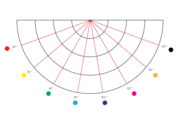
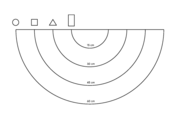
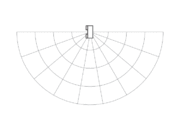
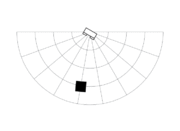
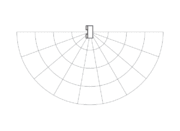
Even though we all had common expertise coming from the Graphic Design department, each adapted to amplify the team.
Some had more interest and expertise in writing the code, while the other was better in building for example the plateau.
Looking back, I figured that my strongest point was to come up with fast ideas. After almost every experiment we needed
to make choices about what our next step would be and what the discovery could add to our project. But what made the
team so great was that we were never alone. We were always working together and talked things over, eventually everybody decided.
Electromagnetic Radiation
Having so little time, also meant that some projects didn’t quit worked out as hoped. For example, my next project working together with Judith and Meike. We hoped to build a Wi-Fi tracker robot. A walking robot that would find the nearest Wi-Fi signal and whenever the signal gets stronger the more excited the robot would get. We were aiming for a humanlike robot to see what reactions we would get from people. To see if people would get just as excited as the robot for instance. We had big dreams and different from before we only had one week. Making the sensor went pretty easy. So we spend more time on building the robot. The robot would exist out of loose ’at home’ parts and a little motor taken from a toy car. But we underestimated the difficulty of making something walk. In the meanwhile, the most important part, the Wi-Fi sensor connected to an Ultra Sonic sensor, broke down at a point that is was too late to order a new one.
Conclusion is that we should have kept it simple and that a toy car would do the job. We could have showed his excitement by blinking lights, instead of waving arms. Probably had been a much stronger idea to use less humanlike features and still be readable. This could make research more interesting. How many features could we give the robot and what will this result? When would people not react on it anymore and how would people feel about a driving toy car that you won’t be steering yourself? We eventually ended up with a lot of loose parts and big dreams. The mistake we maid was focusing too much on how it would look instead of making it work and see it more as a prototype.
Light Radiation The next project was done together with Pascale. We have a mutual interest in material and handcraft, what made our project really fun to do. Our different knowledge in craft complementary each other especially during the experiments. That became clear with our first experiment. As a graphic designer and a bit fond of screen-printing, I know what ink supply we have at school. Pascale on the other hand has next to her big love for the ceramics, some experience in the photo art. We wondered what would happen if we dip a blank piece of paper in UV - light sensitive ink and put it in a camera obscure. Would it result in a picture? It didn’t, but our curiosity grew and we went on experimenting further by mixing UV- sensitive ink and the materials in the ceramics. It worked! Almost all of the materials changed color holding it in UV-light. First thing noticed was the beauty in it slow changing color and the fact that it would only last for 5 minutes the second you take it out of the light. This is when we realized that we had more in common as artists. We both feel that the world around us is moving in such a fast past, that we humans can’t simply catch up anymore. We live in a world where we are surrounded by digital screens, where everything is instant and can be saved forever. So we went for the latex material and decided to make a big screen out of it. Together with a glove tooled with UV-lights we challenge the perspective and let you experience ephemeral drawing.
During this project we struggled a lot whit if we would let people draw themselves and make it an interaction piece or that we would put a machine to work. We experimented with a scanner, where we changed the light bulb for UV-led. I believe I was more pro for the machine idea. I pictured a machine drawing something very slow, that as viewer you had to wait and watch to see the result and eventually you probably never will see the whole result, because after 5 minutes every line made would disappear again. We eventually went for the interactive piece, because we ourselves felt the joy playing with this canvas, so we figured others would too. This project made me think more about the concept of motion and leaded to my next project.
Patterns Being a dancer movement is a very important accept in my life. Something that always felt lacking in my schoolwork. In some way, I just couldn’t find a proper way to immerge my design with movement. I just didn’t see the possibility’s and it felt forced when I tried to. But I discovered that even though most of my work has bin 2D, movement has always been there. Simple example, when I make a drawing I subconscious give it the impression that it is moving. And to enhance this even more I did a course at Animation in my second year. I was most interesting in learning the old way of animation where every step is being hand drawn. You see, it is wrong from me to limit it to just body motion. What I didn’t realize is that my knowledge and interest about motion goes further than that. Motion can move you, it can cause different emotions to a person, it can make you sick like motion sickness. What I find most interesting are the kind that bring you in trance like watching the rain drops making their way down the window or the sun shimmering true Luxaflex on the floor. It’s the patterns and repetition that causes the trance which makes u watch longer than probably intended. I’m a dreamer and in these moments it’s almost as if I am being put to stop, no motor functions or even a realization of where I am and what I was doing. A little pause that I can really enjoy sometimes. And not just in nature, but I found these same qualities in as well in mechanic devises.
I fell in awe with a simple DC motor. To quick comeback at what I said before, this is a great example of how effective starting every project with a workshops was. During this workshop we had to make a speaker out of coper wire, a magnet and a battery. I was so astonished from the simplicity of the mechanic, that it made me do more research. Here I found a similar working object called the DC motor. A simple wire coil is used with a current, generating an invisible electromagnetic field. By placing a magnet underneath the center of the coil, you’ll make the coil turn. Amazing to think that the first electric DC motor was invented in 1832 and is today still in use! The repeating motion and shimmering coper wire makes a beautiful hypnotic illusion. It reminds me of the collision balls with is same physics based magic. Any small adjustment changes the experience completely.
I went on letting go the original function of a motor, from now one its only purpose would be to ‘move’ people. To stay in the concept of patterns, I multiplied the wheels so all the different individual motions would make a new pattern. I chose to use nothing more than needed and kept it as ‘naked’ as possible. The beauty for me lies in the simplicity and I wanted people to see how it works. Eventually I didn’t manage to make it work on time. This made me more passionate about continuing it to the next project, our final project.
